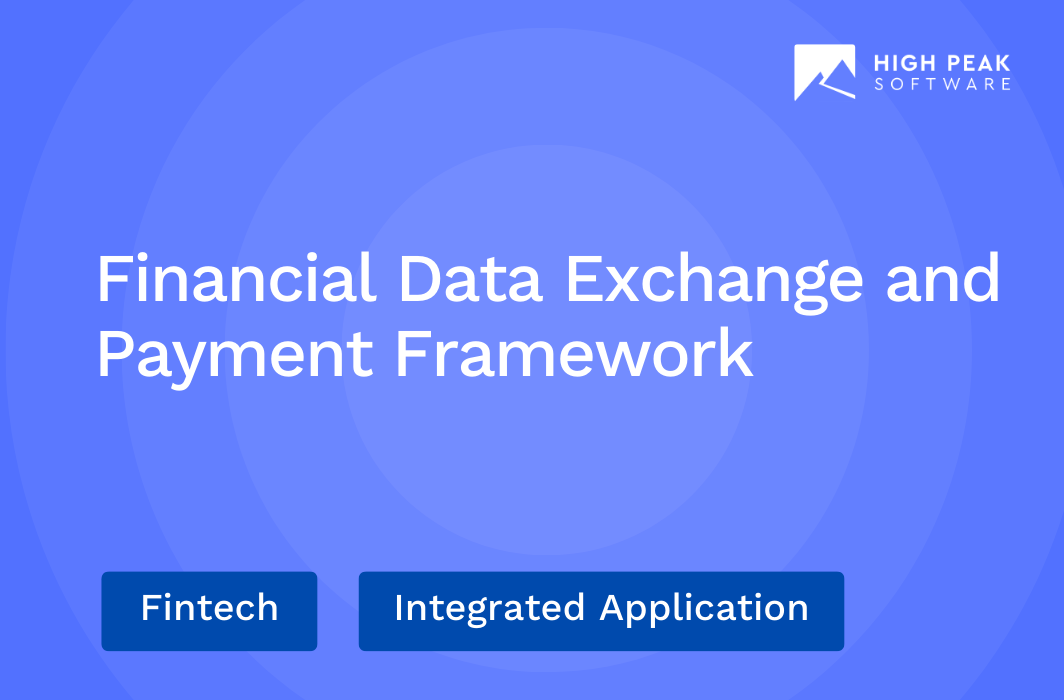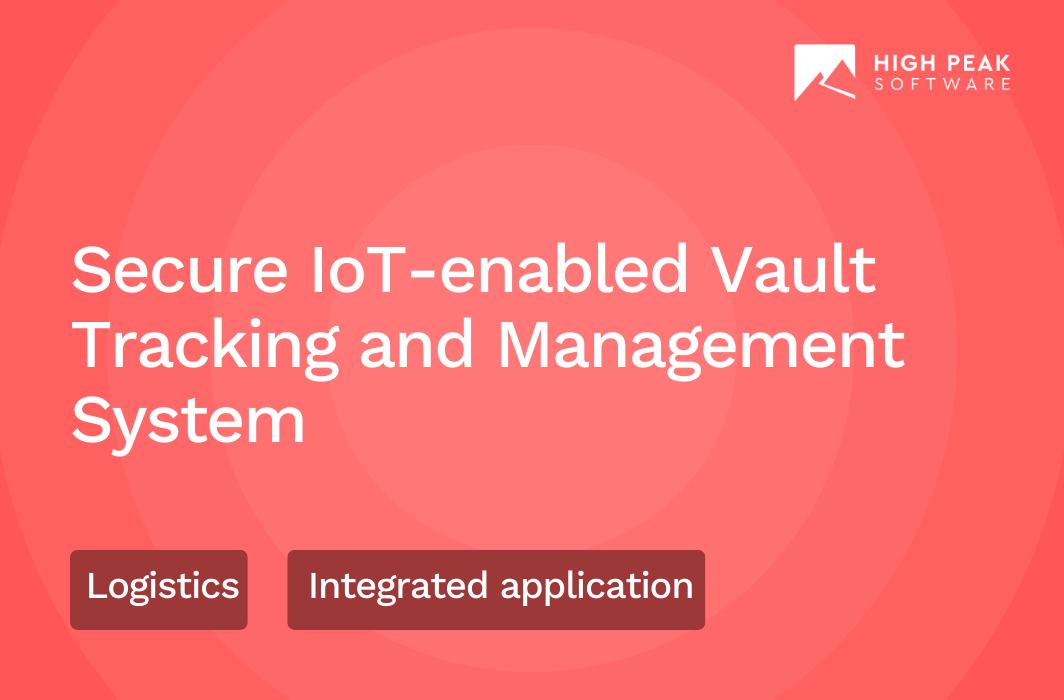Financial Data Exchange and Payment Framework

Table of Contents
- About our client
- Reimagining banking operations: How High Peak developed financial data exchange and payment framework
- Key highlights
- What challenges did our client face that led High Peak to develop these modules?
- Challenges High Peak faced while developing the modules
- Core modules
- Streamlining communication for operations & payments in core banking with the integrated financial data exchange management system
- Seamless transaction journey from payment initiation to realization using the end-to-end payment processing management system
- Navigating financial exceptions: The role of the suspense management system
- Resolving disputes & handling exceptions: Unfolding the transaction dispute management system
- Network directory
- High Peak’s global advantage: Mastering core banking solutions around the world
- Technologies used
- Upcoming modules
- Enhance fintech with High Peak: Streamline global financial operations
Banking professionals face hurdles like cross-border transaction limits and daunting transaction rollbacks. Adding to the complexity, intricate core banking system integrations often lead to delays and potential informational silos. When these challenges persist, they lead to operational inefficiencies, delayed customer service, weakening client trust, and potential financial losses.
This case study focuses on the innovative work of High Peak, a leader in developing advanced core banking solutions tailored for global markets.
About our client
Our client is a global digital banking solutions provider specializing in helping financial institutions achieve digital transformation. Their products cater to various sectors like financial services, insurance, retail, and manufacturing.
With a strong presence in over 100 countries, their innovative core banking system platform and suite of digital engagement tools empower banks to provide top-notch services while optimizing operational efficiency.
Reimagining banking operations: How High Peak developed financial data exchange and payment framework
Our team at High Peak developed numerous modules for the core banking system to simplify and enhance banking processes.
This case study predominantly covers three aspects –
- Financial data exchange management: This module deals with message handling related to transactions, customer communications, and status updates.
- Payment processing system: This module creates payment orders upon receiving messages from the financial data exchange management system. It emphasizes payment validation and requires manual intervention to take the final call. Finally, it processes immediate orders or schedules future-dated transactions accordingly.
- Transaction dispute management: This system handles any transactional anomalies that need reconciliation and dispute management when an erroneous transfer occurs.
In short, the High Peak team developed an advanced core banking payment system as a part of the core banking activities. With these integrated modules in every step, it exchanges and validates data efficiently for payment processing and error resolution in the core banking system.
We aim to streamline the end-to-end payment lifecycle, executing communication, validation, and reconciliation of payment orders without experiencing any downtime or delay.
Key highlights
- The integrated financial data exchange management system is the only part of the system that can communicate with the external world. This core banking system software is unique in its ability to both receive information and transmit messages. It essentially processes structured messages related to financial transactions— both incoming and outgoing. One kind of message it handles is in the ISO format, referred to as the “PAIN” (Payment Initiation) message. and transmits messages, including banking transactions and customer profile configurations.
- The payment processing system entirely manages the end-to-end payment lifecycle, ensuring seamless transitions from initiation to completion. It does 2 stages of validation.
a). ISO validation: Here, it checks technical details as per ISO norms.
b). Business validation: External banking validations, such as time zone, payment method, etc., validate information at this process.
- The errors that are validated in the payment module are then sent to an error-handling repository called the suspense module. Here, the action items are manually done by checking each suspended transaction.
- The transaction dispute management system promptly resolves any errors or issues through a ticket-raising mechanism. It undertakes a series of interactions between the sender, recipient, and their respective banks to resolve the conflict.
What challenges did our client face that led High Peak to develop these modules?
As our client is a global leader providing financial and banking solutions to various industries, many challenges were seen in the prevailing market. Let’s delve into the challenges in detail:
The need for a next-generation core banking system
Banks across the globe no longer rely solely on transaction history and details. The evolution of their processes and functions necessitates a technologically advanced, next-generation system. Particularly, banks require the ability to adapt and implement new business models effectively, something for which citing reference bank models could be beneficial.
Integration with the growing number of banking systems globally
As banking systems evolve and grow in various countries, integration becomes a significant challenge. Clients don’t just need an advanced system; they require one that can build a cohesive link with multiple banking systems across the world. A system that can power a progressive global migration with multiple capabilities becomes the need of the hour.
The requirement for microservices/modules architecture
Financial institutions require a microservices of core banking software architecture that makes it easier to manage and scale business functionalities without getting the entire application. In response to growing and diverse customer demands, banks need an agile delivery model that can achieve speed to market. Implementation of such an architecture provides the much-needed agility to meet these demands.
Interoperability and versatility
The demand for solution modules extends beyond being individually sold and integrated into the existing system. The capability of these modules to communicate and function interoperably with various core banking systems globally is of paramount importance. Versatility, therefore, stands as a significant market challenge needing resolution.
Navigating new technologies to cater to global market demands
The rapid pace of technological advancement in the global banking sector presents an ongoing challenge. Market players often find it difficult to remain abreast with the latest technologies and effectively implement them. Ensuring a smooth transition of new technology into their existing models becomes essential for maintaining market relevance and securing a competitive edge.
Hence, to mitigate these problems, High Peak developed these intricate and advanced modules that are drastically revolutionizing the end-to-end payment management of the core banking system. High Peak addresses the need for compatibility with the proliferating banking systems worldwide while seamlessly integrating advanced technologies and catering to global trends. Through this innovative approach, High Peak directly targets the challenges faced within the evolving financial landscape.
Challenges High Peak faced while developing the modules
Breaking into a new domain always presents unique challenges, and our journey into the banking sector was no different. The High Peak team initially faced a steep learning curve as we navigated unfamiliar terminologies and complex concepts.
Taking the time to gain the necessary insights was not just about overcoming this first challenge; it was about building the foundational knowledge critical to our growth in this field.
Today, our team stands with much brevity in the banking domain, bolstered by experience and deep-dive understanding acquired over time. Our gained competence enables us to confidently undertake banking projects, navigate complexities, and deliver solutions that resonate with our clients’ needs.
While challenges are an inherent part of venturing into new territories, our team has been adapting continuously, strengthening our prowess in the banking sector. This growth and adaptability boost our commitment to creativity, adaptability, and resilience. These qualities, in turn, have strengthened our capabilities to deliver impeccable work regardless of the domain’s complexity.
Core modules
Streamlining communication for operations & payments in core banking with the integrated financial data exchange management system
It is a crucial module within the broader ecosystem of a core banking payment system that our team developed. It primarily serves 3 main functions:
- It receives information from the external systems.
- It transmits messages to the payment processing system and sends the concerned module based on the requirements.
- It does all the configuration and prerequisites of any transaction before the payment order is sent out.
Let’s understand the workflow of the message management system
Integrated message management system
This system ensures end-to-end tracking of banking operations, with timely confirmations from both debtor and creditor banks and the final acknowledgment, signifying transaction completion. It streamlines intra-bank and inter-bank transactions, providing a concise, transparent, and trustworthy payment solution. It is because this system can only communicate with the external world.
The types of messages the integrated message management system handles are generally in the ‘PAIN’ ISO format. ‘PAIN’ is an acronym for Payment Initiation; it designates a specific type of ISO 20022 message.
The “PAIN” message, characteristically an XML file, is received by the message management system. When the financial system is ready to commit the transactions, a follow-up message – referred to as the “PACS.008” message (Payment Clearing message) – is transmitted.
This message, following a standard ISO format, informs the recipient party about the pending transaction meant for settlement and clearing. An example of such a message is ‘PAIN.001’, which indicates a payment instruction.
This message instructs the system to debit a specific amount from the sender’s account and credit a specified number of recipient accounts, which can belong to any bank. Eventually, when it’s time to make the payments, all the instructions in the XML file are used to move the money as specified.
Now let’s see how each file gets processed and how it works in the core banking system:
Creation and management of payment orders
The system initiates by creating payment orders, both bulk and individual, based on the payment instructions received and processed by the message management system. This structured handling of orders, including header, batches (containing records), and footer sections, minimizes errors and enhances overall efficiency.
Notification messages
It triggers essential notifications such as debit and credit alerts, echo messages, and more, ensuring a seamless, transparent banking experience. Throughout this process, the message management system continuously monitors for any validation errors or missing information in replication inputs. If any discrepancies are found, specific error messages will be generated and forwarded to the concerned systems for rectification.
The built-in feature to dispatch notifications like MT 900 and MT 910 facilitates internal communication within financial institutions. These notifications are not sent to external clearing agencies like a country’s Central Bank or the Reserve Bank but are circulated internally to inform relevant departments about specific transaction events.
Canceling payment orders
After the creation and checking phase, the cancellation feature emerges. This system capability allows for generating and managing payment cancellations, offering further strategic flexibility in handling banking transactions.
Clearing system messages
After successfully preparing payments, the message management system sends out another message, termed ‘PACS.008’. ‘PACS’ stands for Payments Clearing and Settlement, an ISO format for sending payments to the recipient or the creditor bank.
Apart from the exchange of these payment messages, the message management system is also responsible for sending out alert messages like ‘PAIN.002)’. It serves as an acknowledgment message indicating that the instructions received have been acknowledged.
Other messages like CAMT 56 (Bank to customer account report) and CAMT 29 (Duplicate report) are sent with this system.
In short, the message management system in the core banking software acts as the communication center between the internal financial system and the external world. It receives, validates, and forwards the payment instructions, then sends out a confirmation or acknowledgment message.
Seamless transaction journey from payment initiation to realization using the end-to-end payment processing management system
The payment processing management in the core banking system software is a crucial part of the financial system. It helps handle payment transactions correctly by processing incoming messages. Here’s a straightforward explanation of this module’s workflow:
Creating payment orders
1. Understanding incoming messages
It all starts when an original message comes in from an outside source. The message management system receives this initial message and determines its type. For instance, if the message type is ‘PAIN.001’, it indicates that a new payment order needs to be created. This is essentially a signal for action to be taken.
2. Create payment information through payment orders
Upon receiving the signal to create a new payment order, the message management system passes the information to the payment processing system. It grabs this information and creates a specific kind of message, called an ISO-formatted message.
Think of this as a translator converting the information it has been given into a language (or message format) that everyone in the system can understand. Also, this ISO message is the official payment instruction.
3. Checking the payment order
Next, the payment order goes through a quick check-up. It makes sure that all the details are in order. This includes:
Verifying the account numbers – This step involves validating that both the sender’s and receiver’s account numbers are correctly formatted and valid.
Assessing the transaction amount – The module checks if the transaction amount is within the permissible limits defined by the bank or regulatory body.
Checking currencies – The Payment Module confirms if the transaction currency is valid and supported by both sending and receiving banks.
Evaluating account status – This step ensures that both the sender’s and receiver’s bank accounts are active and capable of processing the transaction.
Confirming beneficiary details – A critical step that involves verifying the correctness of the receiver’s account details to ensure smooth transactions.
Assessing transaction type – It ensures the transaction method chosen, whether wire transfer, ACH transfer, or others, is valid and correctly timed.
Validation of payment orders
Once the payment order passes this check-up, it gets an official “seal of approval”, and the payment order is generated. This confirmed payment order is then passed back to the message management system.
This system doesn’t send the instructions to individual banks like your local banking branch. Instead, it communicates with a reserve bank or central clearing system agency known as the clearing system. The system performs two primary types of validation: ISO validations and business validations. Let’s see them in detail:
The differences in the types of validation and their responsibilities lie mainly in the level of concern and the nature of the checks performed.
1. ISO validation
This is the first level of validation, where syntactic and format verification of the message happens. In this case, the message management system checks whether the received message adheres to the ISO rules and regulations.
This process confirms that the message has been structured correctly (syntax), contains all the necessary fields, and every piece of data in those fields is of the right kind (format).
For instance, account numbers consist only of numbers, not letters, among other checks. This validation ensures the message can be processed in its most fundamental form.
2. Business validation
Following the ISO validation, the payment processing system then conducts business validations. These are more intricate verifications that are highly dependent on various factors such as geography, financial institution rules, payment channels, and regulations of different clearing systems.
A potential example of a business validation might be that a specific kind of transaction (like real-time transfers) can only be performed within certain hours of the day. Another case might be checking if there are enough funds in an account to carry out a transaction.
These validations performed by the payment processing system are crucial to ensure that the payment should happen as instructed. If it has to happen immediately, the payment order is created without delay. However, if a future date has been specified for the transaction, the payment order is stored (warehoused) and will be executed at the designated time.
In short, both ISO and business validations work together to create an efficient, reliable, and accurate payment process. They ensure every transaction adheres to all necessary guidelines, whether those be general transaction rules (ISO) or more context-specific (business).
Navigating financial exceptions: The role of the suspense management system
In a seamless financial transaction ecosystem, the suspense management system plays a crucial role when errors occur during the business validation process undertaken by the payment processing system.
When an error occurs, instead of rejecting the transaction altogether, the system pushes the transaction into a separate area known as the “suspense”.
Here, invalid transactions are held and separated from regular processing queues, pending further inspection and action. This is precisely where the suspense management module comes in.
It notifies users (bank staff or system administrators) that there’s a stalled transaction that needs their attention. The user then manually checks the details of the erroneous transaction and determines the best course of action.
There are three primary actions a user can take when managing suspense items in the core banking system software:
Repair the transaction: If the error is due to incorrect or missing information, the user can correct the errors or provide the missing information. The transaction is then released from the suspense area and continues its journey in the typical processing flow.
Override/ignore/pass-on the transaction: If the user finds the error isn’t significant enough to stop the transaction or the transaction is valid despite the validation check failure, the transaction can be approved manually. This action effectively overrides the initial error warning.
Reject the transaction: If the error is too significant or cannot be corrected, the user can reject the transaction, terminating its journey in the payment processing flow.
All in all, the suspense management module serves as a safeguard, catching any transactions that fail to meet the business validation checks. It empowers the user with the ability to take appropriate action depending on the nature of the issue. Thus ensuring the processing flow’s integrity, security, and accuracy.
Resolving disputes & handling exceptions: Unfolding the transaction dispute management system
The transaction dispute management system in the core banking system software is a specialized framework designed to handle complex scenarios within the financial transaction life cycle. It takes charge of exceptions and dispute handling.
Thus ensuring every departure from a normal transaction route is adequately addressed. The aim of this system is to achieve resolution by resolving tickets that are raised using standard procedures and protocols. Now let’s see it in detail:
Exception handling
Exceptions occur when a process or transaction deviates from its normal flow or an error occurs. In the context of banking operations, examples could include:
- A transaction was made by mistake.
- The receiver of funds disputes the legitimacy of the transaction.
The transaction dispute management system identifies issues and initiates an inquiry or cancellation request at the sender’s bank. The sender’s bank then communicates this to the receiving bank.
Disputes handling
A dispute arises when parties involved in a transaction disagree on certain aspects of that transaction. Disputes often involve a conflict that needs some level of mediation or intervention. In relation to banking transactions, this could involve situations like:
- The receipt of funds where the sender later realizes it was sent to the incorrect recipient and wishes to reverse the transaction.
- The sender disputes having authorized a transaction.
In these cases, the case management system steps in, undertaking a series of interactions between the sender, recipient, and their respective banks to resolve the conflict.
Network directory
This system in the core banking system software offers simplicity and efficiency to banking operations, taking care of complex tasks like managing a detailed Bank Identifier Codes (BIC) directory. It enables users to easily configure, upload, and handle essential bank details, streamlining data management and bank communications.
Plus, with automatic retrieval of bank details for payment order creation and a quick search feature powered by caching through Redis, this module adds speed and accuracy to your banking operations. This user-friendly feature is designed to make bulk data handling and information retrieval a breeze for our clients.
High Peak’s global advantage: Mastering core banking solutions around the world
Every country has its unique banking system with its own set of complexities. Handling international transactions requires not just an understanding of these systems but also the ability to interlink them smoothly. This is where High Peak truly shines.
We specialize in creating flexible core banking system software that can easily adapt to different banking environments.
India
We have worked extensively with NEFT (National Electronic Funds Transfer) and IMPS (Immediate Payment Service), a real-time interbank payment service in India available 24/7. It allows for seamless and fast transactions, underlining our capabilities to adapt to local systems.
Hong Kong
Our significant experience with the HKFPS (Hong Kong Faster Payment System) caters to the city’s demand for quick, efficient money transfers. This system enables round-the-clock interbank transfers within Hong Kong.
Europe
Our expertise extends to the SWIFT (Society for Worldwide Interbank Financial Telecommunications) payment system, which is primarily used in Europe. As an international payment method, SWIFT enables banks to send money securely worldwide, and High Peak’s familiarity with this system ensures secure and quick cross-border transactions.
Australia
We have also developed solutions compatible with Australia’s NPP (New Payments Platform), an advanced infrastructure that lets consumers, businesses, and government agencies make real-time, data-rich payments between accounts at participating financial institutions. Our proficiency in integrating with this Australian platform highlights our adaptability to various banking landscapes.
Mexico
We have mastered Mexico’s domestic electronic payment system, SPEI (Sistema de Pagos Electrónicos Interbancarios/ Interbanking Electronic Payment System), which enables real-time transfers between participating institutions and showcases our versatility in handling region-specific payment systems.
United States
In the US, High Peak has explored the Real-Time Payments system (US-RTP), which supports the instant transfer of money between accounts 24/7. This demonstrates our ability to cater to instantaneous banking needs in a dynamic and fast-paced market.
At High Peak, we go beyond just catering to the specificities of each banking system. Also, we provide solutions that seamlessly bridge the gap between these systems, effectively facilitating international transactions.
Our robust understanding of these systems, backed by the flexibility of our solutions, ensures smooth interoperability between international transactions across different banking systems. Therefore, we can confidently handle any banking project, irrespective of the geographical location or the distinct banking system involved. With High Peak, you’re assured of top-notch, personalized, and efficient banking solutions.
Technologies used
Backend:
Node.js, NodeRed, Postgres, MongoDB, ESLint, SonarLint, Loopback, Redis, Oracle and RabbitMQ
Testing:
Backend (Unit testing and component testing): Mocha
Front-end testing: WebdriverIO
Upcoming modules
- Swiss RTP (Real Time Payments)
- SEPA (Single Euro Payments Area)
Enhance fintech with High Peak: Streamline global financial operations
High Peak brings unparalleled expertise, innovative solutions, and a profound comprehension of the global banking landscape. Our flexible core banking modules facilitate seamless, millisecond transactions across various geo-specific banking systems, underscoring our commitment to technological excellence.
If your financial institution is seeking to enhance operational efficiencies and customer satisfaction, partner with High Peak, where cutting-edge banking solutions meet global applicability. Contact us to develop such core banking systems.




